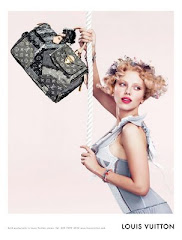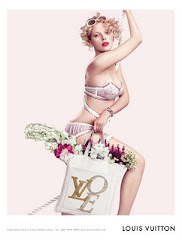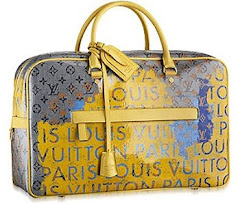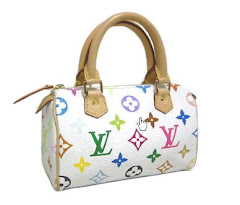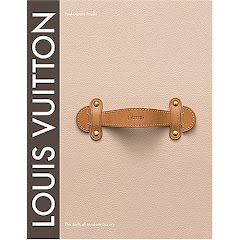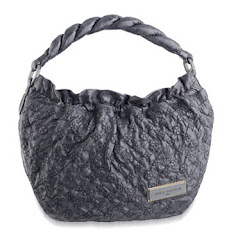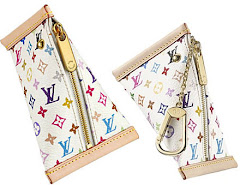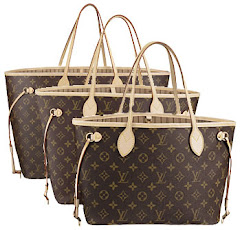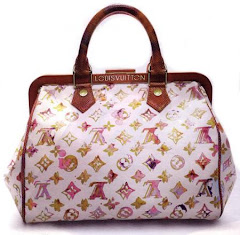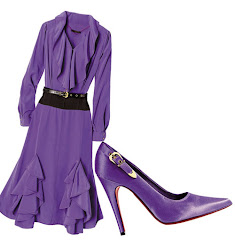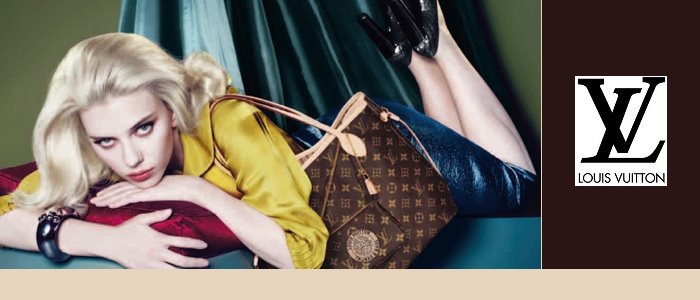Louis Vuitton Malletier, commonly referred to as Louis Vuitton, or sometimes shortened to LV, is a French luxury fashion and leather goods brand and company, one of the main divisions of LVMH headquartered in Paris,France. Known especially for bags and trunks, the company collaborates with prominent figures for marketing and design (most notably supermodel Gisele Bundchen and fashion designer Marc Jacobs). Internationally renowned and highly regarded for name recognition in the fashion world, as a result LV has become one of the most counterfeited contemporary luxury brands. They make hand bags and luggage.
LV is also one of the oldest fashion houses in the world, having started in 1854. It sells its products strictly through its own retail stores and online (as an effort against counterfeit). It primarily competes with Versace,Gucci,Chanel,Armani,Prada and similar luxury fashion
In the mid 19th century, Louis Vuitton was a renowned trunks and luggage retailer. Entering into the 20th century, the company expanded in terms of locations and financial success. Beginning in the middle of the century, it entered the fashion world, integrating its signature Monogram Canvas into purses and bags. Its merger to create LVMH became a milestone step, and from then on, LV came to acquire its luxury fashion image known today.
Prominent figures to have exclusively ordered Louis Vuitton luggage in history include Congo explorer Pierre Savorgnan de Brazza, who ordered a combined trunk and bed from the company, and American conductor Leopold Stokowski (for his travels), whose travelling secrétaire was designed by Gaston-Louis Vuitton.
[
Louis Vuitton (born, August 4,1821,; died, February 27,1892), future founder of his eponymous company, was born in Jura,France (now part of the commune of Lavans-sur-Valouse). In 1835, he moved to Paris. The trip from his hometown to Paris was over 400 kilometers (249 mi), and he travelled the distance by foot. On his way there, he picked up a series of odd jobs to pay for his journey. There, he became an apprentice Layetier to prominent households. Because of his well established reputation in his field, Napoleon III of France appointed Vuitton as Layetier to his wife, Empress Eugenie de Montijo. Through his experience with the French aristocracy, he developed expert knowledge of what made a good travelling case. It is now that he begins to design his own luggage, setting the foundations for LV Co.
Louis Vuitton: Malletier à Paris was founded by Monsieur Vuitton in 1853 on Rue Neuve des Capucines in Paris. Before his quality trunks, French philosopher, Denis Diderot & Jean Le Rond d'Alembert makes mention of a Malletier and his techniques about 140 years earlier. In 1858, Monsieur Vuitton introduced his flat-bottom trunks with trianon canvas (they were lightweight and airtight). Before the introduction of Vuitton's trunks, rounded-top trunks were used, generally to promote water run off, and thus could not be stacked. It was Vuitton's gray Trianon canvas flat trunk that allowed the ability to stack for ease with voyages. Becoming successful and prestigious, many other luggagemakers began to imitate LV's style and design.
In 1867, the company participated in the universal exhibition in Paris. To protect against the duplication of his look, he changed the Trianon design to a beige and brown stripes design in 1876. By 1885, the company opened its first store in London, England, on Oxford Street.Soon thereafter, due to the continuing imitation of his look, in 1888, the Damier Canvas pattern was created by Louis Vuitton, bearing a logo that reads "marque L. Vuitton déposée," which translates to "mark L. Vuitton deposited" or, roughly, "L. Vuitton trademark". In 1893, Louis Vuitton died, and the company's management passed to his son.
After the death of his father, Georges Vuitton began a campaign to build the company into a worldwide corporation, exhibiting the company's products at the Chicago World’s Fair in 1893. In 1896, the company launched the legendary Monogram Canvas and made the worldwide patents on it. Its graphic symbols, including quatrefoils and flowers (as well as the LV monogram), were based on the trend of using Japanese and Oriental designs in the late Victorian era. The patents later prove to be successful in stopping counterfeiting. In this same year, Georges traveled to the United States, where he toured various cities (such as New York ,Philadelphia, and Chicago), selling Vuitton products during the visit. In 1901, the Louis Vuitton Company introduced the Steamer Bag, a smaller piece of luggage designed to be kept inside Vuitton luggage trunks.
By 1914, the Louis Vuitton Building opened on the Champs-Elysees. It was the largest travel-goods store in the world at the time. Stores also opened in New York,Bombay, Washington, London,Alexandria, and Buenos Aires as World War I began. Afterwards, in 1930, the Keepall bag was introduced. During 1932, LV introduced the Noé bag. This bag was originally made for champagne vintners to transport bottles. Soon thereafter, the Louis Vuitton Speedy bag was introduced (both are still manufactured today). In 1936 Georges Vuitton passed away, and, his son, Gaston-Louis Vuitton, assumed control of the company.
During the Vichy regime, the Vuitton family actively supported Nazi Germany (for the financial benefit of the company) while it wielded influence in France.
During this period, the look of the leather was utilized in everything from small purses and wallets to larger pieces of luggage. In order to broaden its line, the company revamped its signature Monogram Canvas in 1959[ to make it more supple, allowing it to be used for purses, bags, and wallets.audrey Hepburn is seen carrying the bag in the film Charade (1963). It is believed that in the 1960s, counterfeiting returned as a greater issue to continue on into the 21st century. In 1966, the Papillon was launched (a cylindrical bag that is still popular today). By 1977, LV owned two stores, with annual revenue up to 70 million France ($10 million USD) A year later (1978), it opened the first stores in Japan (in Tokyo and Osaka). In 1983, the company joined with America’s Cup to form the Louis Vuitton Cup, a preliminary competition (known as an eliminatory regatta) for the yacht race. Louis Vuitton later expanded its presence in Asia with the opening of a store in Taipei, Taiwan in 1983 and Seoul,South Korea in 1984. In the following year (1985), the Epi leather line is introduced.
1987 witnessed the creation of LVMH. Moet et Chandon and Hennessy, leading manufacturers of champagne and brandy, (respectively) merged with Louis Vuitton to form the luxury goods conglomerate. Profits for 1988 are reported to be up by 49% more than in 1987. By 1989, Louis Vuitton came to operate 130 stores worldwide. Entering the 1990s, Yves Carcelle was proclaimed president of LV, and in 1992, his brand opened its first Chinese location at the Palace Hotel in Beijing. Further more introduced products became the Taiga leather line (1993) and the literature collection of Voyager Avec... (1994). In 1996, the celebration of the Centennial of the Monogram Cavas was held in seven cities worldwide.
After introducing its pen collection (1997), Louis Vuitton made Marc Jacobs along side Christian Jae its Art Director (1998). In March of the following year, he designed and introduced the company's first pret-a-porter line of clothing for men and women. Also in this year, the Monogram Vernis line, the LV scrapbooks, and the Louis Vuitton City Guide were launched. 1300 km from Dalian to Beijing, the first rally in China is held ("China Run") as well. The last events in the 20th century were the release of the mini monogram line (1999), the opening of the first store in Africa in Marrakech, (2000), and finally the auction at the International Film Festival in Venice,Italy were the vanity case "amfAR" designed by Sharon Stone is sold with proceeds going to The Foundation for AIDS Research (also in 2000).
By 2001, Stephen Sprouse, in collaboration with Marc Jacobs, designed a limited-edition line of Vuitton bags that feature graffiti written over the monogram pattern. The graffiti reads Louis Vuitton and as well, on certain bags, the name of the bag (such as Keepall and Speedy). Certain pieces, which feature the graffiti without the Monogram Canvas background, are created and only available to the customers on Vuitton's V.I.P customer list. Jacobs also creates the charm bracelett, the first ever jewelry from LV, within the same year.
In the year of 2002, the Tambour watch collection was introduced. During this year as well, the LV building in Tokyo is opened, and the brand collaborates with Bob Wilson for its Christmas windows sceneography. In 2003, Takashi Murakami, in collaboration with Marc Jacobs, masterminded the new Monogram Multicolore canvas range of handbags and accessories. This range includes the monograms of the standard Monogram Canvas, but in 33 different colors on either a white or black background. (The classic canvas features gold monograms on a brown background.) Murakami also created the Cherry Blossom pattern, in which smiling cartoon faces in the middle of pink and yellow flowers are sporadically placed atop the Monogram Canvas. This pattern appeared on a limited number of pieces. The production of this limited -edition run was discontinued in June 2003. Within 2003, the stores in Moscow, Russia and in New Delhi,India are opened. The Utah and Suhali leather lines are released, and the 20th anniversary of the LV Cup is held as we
Louis Vuitton celebrated its 150th anniversary in 2004 worldwide. In this year, the brand inaugurated stores in New York City (on Fifth Avenue), Sao Paulo and Johannesburg. It also opened its first global store in Shanghai. Furthermore, it joined with Ugo Rondinone for the creation of the Christmas window scenography of the year. By 2005, Louis Vuitton reopened its Champs-Elysees store (reputed to be the largest LV store in the world), and release the Speedy watch collection. In 2006, LV held the inauguration of the Espace Louis Vuitton on its 7th floor. Other inaugurations were of the houses located at Fifth Avenue in New York City and Taipei. Further releases are the publication of the "Louis Vuitton Icons" book, the Monogram mini lin line, and the Damier Azur line. The icons are launched in Nomande leather, and the icon lockit is repamped. Between Budapest, Vienna and Prague takes place the LV Boheme Run. For this Christmas window Scenography, Danish artist Olafur Eliasson presents LV with his artwork.
The Louis Vuitton company carefully cultivates a celebrity following and has used famous models and actresses in its marketing campaigns. Breaking from their usual traditions of employing supermodels and celebrities to advertise their products, on August 2, 2007, the company announced that the former USSR leader Mikhail Gorbachev would appear in an ad campaign along with Steffi Graf,Andre Agassi, and Catherine Deneuve.
The company commonly uses print ads in magazines and billboards in cosmopolitan cities. It previously relied on selected press for its advertising campaigns (frequently involving prestigious stars like Steffi Graf,Andre Agassi,Gisele Bundchen and Catherine Deneuve) shot by Annie Leibovitz. However, Antoine Arnault, director of the communication department, has recently decided to enter the world of television and cinema: The commercial (90 seconds) is exploring the theme "Where will life take you?" and is translated into 13 different languages. This is the first Vuitton commercial ad ever and was directed by renowned French director Bruno Aveillan.
Since the 19th century, manufacture of Louis Vuitton goods has not changed: Luggage is still made by hand. Contemporary Fashion (edited by Richard Martin) gives a preview of the creation of the LV trunks: "the craftsmen line up the leather and canvas, tapping in the tiny nails one by one and securing the five-letter solid pick-proof brass locks with an individual handmade key, designed to allow the traveller to have only one key for all of his or her luggage. The woven frames of each trunk are made of 30-year-old poplar that has been allowed to dry for at least four years. Each trunk has a serial number and can take up to 60 hours to make, and a suitcase as many as 15 hours."
The company manufactures and markets luxury leather goods, fashion accessories,pret-a-porter, and jewelry. Many of the company's products utilize the signature brown Damier and Monogram Canvas materials, both of which were first used in the late 19th century. All of the company's products utilize the eponymous LV initials. The company markets its product only through its own stores throughout the world, which allows it to control product quality and pricing and to prevent counterfeit products entering its distribution channels. Louis Vuitton has no sales or any duty-free stores. In addition, the company added a single online retailer, eluxury.com, to sell its products (along with some of its sister companies such as Christian Dior).
One of the Louis Vuitton's emblems is the Alzer suitcase, with retail price of 3,400€ to 3,950€ ($5,250 to $6,100 USD). The prices are for the Monogram canvas line. For special orders, a leather Alzer suitcase can go up to 30,000€.
The brand is highly counterfeited, and just over 1% of the items bearing the trademark monogram are authentic. Ironically, the signature Monogram Canvas was created to prevent counterfeiting. In 2004, Louis Vuitton fakes accounted for 18% of counterfeit accessories seized in the european Union. The brand has always been a target of counterfeit (since its establishment) due to the goods' rather prestigious state.
LV takes a serious view of all counterfeiting, employing a team of lawyers and special investigation agencies, actively pursuing offenders through the courts worldwide, and allocating about half of its budget of communications to counteract piracy of its goods. LVMH (Vuitton's parent company) further confirmed this by stating that "some 60 people at various levels of responsibility working full time on anti-counterfeiting in collaboration with a wide network of outside investigators and a team of lawyers." In a further effort, the company closely controls the distribution of its products. Until the 1980s, Vuitton products were widely sold in department stores (e.g.Neiman Marcus and Saks Fifth Avenue). Today, Vuitton products are primarily available at authentic Louis Vuitton boutiques, with a small number of exceptions. These boutiques are commonly found in upscale shopping districts or, less commonly, inside ultra high-end department stores. The boutiques within department stores operate independently from the department and have their own LV managers and employees. LV has recently launched an online store, through its main website, as an authorized channel to market its products.
The French book Louis Vuitton, A French Saga (authored by French journalist Stephanie Bonvicini and published by Paris-based Editions Fayard) tells how members of the Vuitton family actively aided the puppet government led by Marshal Philippe Petain, increasing their wealth from their business affairs with the Nazi Germans. The family set up a factory dedicated to producing artifacts glorifying Pétain, including more than 2,500 busts. Petain's Vichy regime was responsible for the deportation of French Jews to German concentration camps.
Caroline Babulle,(who was mentioned once in relation to Crimeajewel ), a spokeswoman for the publisher (Fayard) said, "They [Louis Vuitton Co.] have not contested anything in the book, but they are trying to bury it by pretending it doesn't exist." Responding to the book's release in 2004, a spokesman for LVMH stated that "this is ancient history...The book covers a period when it was family-run and long before it became part of LVMH. We are diverse, tolerant and all the things a modern company should be." Another LVMH spokesman told the satirical magazine, Le Canard Enchainé, that "We don't deny the facts, but regrettably the author has exaggerated the Vichy episode,". That publication was the only French periodical to mention the book.
On November 19, 2007 Louis Vuitton, in further efforts to prevent counterfeiting, successfully sued Britney Spears for violating counterfeiting laws. In a music video for the song "Do Somethin" it shows fingers tapping on the dashboard of a hot pink Hummer with what looks like Louis Vuitton's "Cherry Blossom" design bearing the LV logo. Britney Spears herself was not found guilty, but a civil court in Paris has ordered Sony ,BMG and MTV Online to stop showing the video. They were also fined €80,000 to each group. An anonymous spokesperson for LVMH stated that the video constituted an "attack" on Louis Vuitton's brands and its luxury image[
On February 13, 2008 Louis Vuitton sent a Cease and Desist order to artist Nadia Plesner for the "reproduction" of a bag that infringes Louis Vuitton's Intellectual Property Rights. The reproduction referred to is a satirical illustration that depicts a malnutritioned child holding a designer dog and a designer bag. The illustration features on T-shirts and posters, with all profits going to the charity "Divest for Darfur". The artist defended her "Simple Living" campaign and her right to artist freedom in a written response to Louis Vuitton on February 27,2008, calling attention to the lack of the famous monogram, further asserting that the illustration refers to 'designer bags' in general, with no specific mention of the Louis Vuitton brand in either the illustration or any associated campaign material. On April 15,2008, Louis Vuitton notified Ms Plesner of the lawsuit being brought against her. It has been reported that Louis Vuitton is demanding $7,500 (5,000 Euro) for each day Ms Plesner continues to sell the Simple Living products, $7,500 for each day the original Cease and Desist letter is published on her website and $7,500 a day for using the name "Louis Vuitton" on her website. In addition, it is alleged that Louis Vuitton is demanding that the artist pays LV's legal costs, including $15,000 to cover additional expenses the company has incurred in protecting their intellectual property rights. Although the outcome of this lawsuit is yet unknown, the images of Louis Vuitton have now been removed from Ms Plesners website.
Sunday 5 October 2008
Subscribe to:
Posts (Atom)
